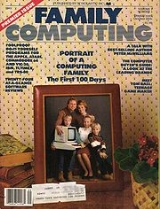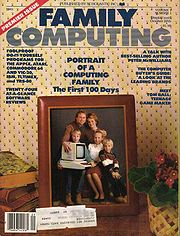
Family Computing
Encyclopedia
Family Computing was a 1980s U.S. computer magazine published by Scholastic, Inc.. It covered all the major home computer
platforms of the day including the Apple II
series, Commodore Vic 20 and 64
, Atari 8-bit family
as well as the IBM PC
and Apple Macintosh. It printed a mixture of product reviews, how-to articles and type-in programs. The magazine also featured a teen-oriented insert called K-Power, written by Stuyvesant High School
students called the Special-K's. The section was named after a former sister magazine which folded after a short run. The magazine was notable in the early days for the wide variety of systems it supported with type in programs, including such "orphaned" systems as the Coleco Adam
and TI 99/4A long after other magazines discontinued coverage. There was also a spinoff TV show on Lifetime hosted by the late Larry Sturholm.
Another section of the magazine was contributed by Joey Latimer and dealt with music related themes. This mostly amounted to BASIC program listings that would play some sort of tune on the computer platforms covered by the magazine.
 After the North American video game crash of 1983 the magazine began to change its focus toward the burgeoning home office
After the North American video game crash of 1983 the magazine began to change its focus toward the burgeoning home office
movement of the late 80s and early 90s, initiating coverage of non-computing products such as fax machines and office furniture. Article topics began to include ideas for starting a home business and time management tips. The title was changed, first to "Family & Home Office Computing" and finally to just "Home Office Computing" with ever-diminishing coverage of home computing topics.
Home computer
Home computers were a class of microcomputers entering the market in 1977, and becoming increasingly common during the 1980s. They were marketed to consumers as affordable and accessible computers that, for the first time, were intended for the use of a single nontechnical user...
platforms of the day including the Apple II
Apple II
The Apple II is an 8-bit home computer, one of the first highly successful mass-produced microcomputer products, designed primarily by Steve Wozniak, manufactured by Apple Computer and introduced in 1977...
series, Commodore Vic 20 and 64
Commodore 64
The Commodore 64 is an 8-bit home computer introduced by Commodore International in January 1982.Volume production started in the spring of 1982, with machines being released on to the market in August at a price of US$595...
, Atari 8-bit family
Atari 8-bit family
The Atari 8-bit family is a series of 8-bit home computers manufactured from 1979 to 1992. All are based on the MOS Technology 6502 CPU and were the first home computers designed with custom coprocessor chips...
as well as the IBM PC
IBM PC
The IBM Personal Computer, commonly known as the IBM PC, is the original version and progenitor of the IBM PC compatible hardware platform. It is IBM model number 5150, and was introduced on August 12, 1981...
and Apple Macintosh. It printed a mixture of product reviews, how-to articles and type-in programs. The magazine also featured a teen-oriented insert called K-Power, written by Stuyvesant High School
Stuyvesant High School
Stuyvesant High School , commonly referred to as Stuy , is a New York City public high school that specializes in mathematics and science. The school opened in 1904 on Manhattan's East Side and moved to a new building in Battery Park City in 1992. Stuyvesant is noted for its strong academic...
students called the Special-K's. The section was named after a former sister magazine which folded after a short run. The magazine was notable in the early days for the wide variety of systems it supported with type in programs, including such "orphaned" systems as the Coleco Adam
Coleco Adam
The Coleco Adam is a home computer, an attempt in the early 1980s by American toy manufacturer Coleco to follow on the success of its ColecoVision game console...
and TI 99/4A long after other magazines discontinued coverage. There was also a spinoff TV show on Lifetime hosted by the late Larry Sturholm.
Another section of the magazine was contributed by Joey Latimer and dealt with music related themes. This mostly amounted to BASIC program listings that would play some sort of tune on the computer platforms covered by the magazine.

Small office/home office
Small office/home office, or SOHO, refers to the category of business or cottage industry which involves from 1 to 10 workers. SOHO can also stand for single office/home office....
movement of the late 80s and early 90s, initiating coverage of non-computing products such as fax machines and office furniture. Article topics began to include ideas for starting a home business and time management tips. The title was changed, first to "Family & Home Office Computing" and finally to just "Home Office Computing" with ever-diminishing coverage of home computing topics.

